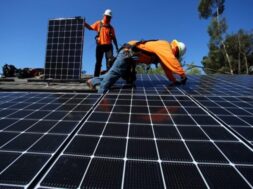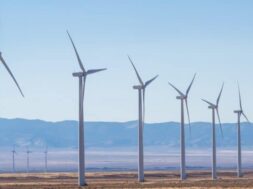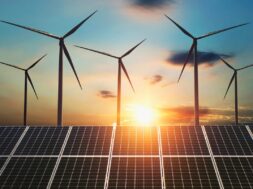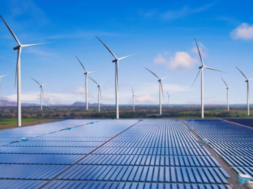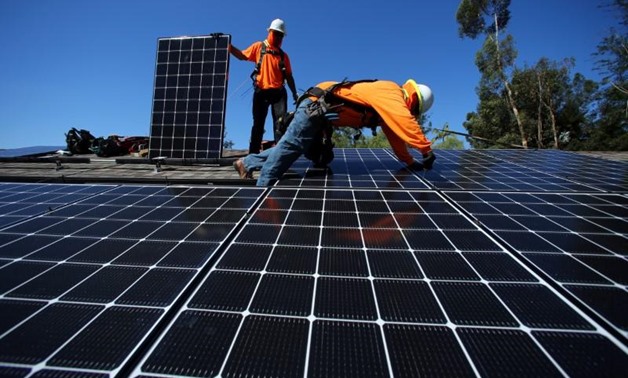
In Short : The sun, as a perpetual source of solar energy, plays a crucial role in addressing climate change challenges. Solar energy harnesses the sun’s power through technologies like solar panels, offering a clean and renewable alternative to fossil fuels. By reducing reliance on non-renewable resources, solar energy contributes to mitigating climate change, decreasing greenhouse gas emissions, and fostering a more sustainable energy future.
In Detail : With regard to solar energy supply chains, India seems to be evolving. It has an arduous solar goal, but has already added 74 GW of solar capacity by 2023
On Makara Sankaranti last month, the Sun’s lustrous chariot entered the constellation of Capricorn on its journey through the heavens. We have also just witnessed the historic Prana pratishthapana of Lord Rama, the scion of the solar Ikshvaku royals. Most appropriately at this time, the prime minister has announced a Suryodaya Yojana, i.e. the installation of solar panels on the roofs of one crore houses, to generate cost-free electricity. This telescoping of aeons in time showcases what might well be called Indic modernity, where the ancient principles of our Sanatani traditions inform a modern aspirational nation, the rashtra guiding the rajya, as it always must in a civilisational state.
His announcement led me to think about solar energy, and about energy in general. We scientists are taught about energy right from school. We are told there are different forms of interconvertible energy. In fact, bits of biology, some of chemistry, most of physics and all of engineering is connected with the ways in which energy transformations occur and can be controlled. The First Law of Thermodynamics also ordains that energy cannot be created or destroyed, rather its forms merely interconverted. Yet, we were never taught that the basis for this law and other things we learnt about energy arise from the simple fact that all the energy we have on this earth is what is received from the sun, directly or otherwise. The sun is the supreme giver of energy, the jagatprakasa, who lights up the whole world with his tejas sphurti.
Every ancient culture, including Egypt, Sumeria, Akkadia, Bharat and Peru, had some form of solar worship that was integral to their religions. To these peoples, the sun was the bestower of light and life to the totality of their known cosmos. With his unblinking, omniscient eye as the Lokasakshi, he was the stern guarantor of justice. With the almost universal connection of light with enlightenment or illumination, the sun was and remains, allegorically speaking, the source of wisdom. In our own culture which had a well-developed urban civilisation, there was a strong ideology of sacred kingship, associated with the Sun God, Surya. He is the father of Yama and Sani, the Lords of the afterlife and justice, respectively. The qualities of sovereignty, power of beneficence, justice, and wisdom were central to Lord Rama, the scion of the solar dynasty and the source of our well-developed solar ideology.
Further introspection led me to conclude that the ancients, in all cultures, contemplated the Sun seriously enough to come to the realisation that control of energy interconversions, a remixing of Surya’s gifts, is what is required for a better quality of life. The first fires helped keep people warm, the first ox-drawn carts with wheels helped them move heavy things around easily, and fast forwarding through a few centuries, the steam engine replaced horses, the incandescent bulb replaced oil lamps, and the aeroplane replaced the steam engine. All these technologies are but simple examples of energy transfers, all well within the four corners of the First Law, and all have completely transformed the world as we know it today.
While coal has been known from time immemorial, the modern use of petroleum as a fuel around two centuries ago transformed the world’s energy profile. These fossil fuels, along with natural gas, are found in shallow regions of the earth’s crust and are produced over long time periods aided by the higher temperatures and pressures that are obtained below the ground or the sea—a conversion of mechanical to chemical energy. When fossil fuels are burnt or ignited, the chemical energy becomes thermal energy and may be used to drive machines—a conversion back to mechanical energy.
Fossil fuels have remained the main source of thermal energy for us and they are quite easy to extract from the earth’s crust. Most manufacturing and almost all modes of modern travel need fossil fuels. Most industries that need heating of a substance require fossil fuels in one way or another. For these reasons, it is estimated that fossil fuels account for 80 per cent of our entire energy needs today. This number is unacceptably high because the burning of fossil fuels is environmentally harmful and increases the amount of carbon dioxide released into the atmosphere, the so-called carbon footprint.
Another aspect of petroleum and natural gas, no less significant than the first, is that it is found in only a few areas of the world, mostly in the Middle East but also in the US, Venezuela, Nigeria and under the North Sea. The refining and movement of petroleum is somewhat in the hands of the countries where it is found, but a small conglomerate of Western countries—notably the US, the UK, Australia, Canada and Norway—control oil producers through various methods and are referred to as ‘planet wreckers’ on account of their cynical attitudes to climate change.
New alliances between Russia and India have also thickened the geopolitical soup. The main consumers of fossil fuels are the US, India and China. Many geopolitical calculations today seem to hinge on how effectively these major consumers get access to the oil they need. In this context, the importance of the Indian Ocean region and the strategic positioning of two choke points of water at its either end—the Straits of Hormuz and the Gulf of Malacca—have determined foreign policy issues for possibly half the countries of the world at present. Much of our current problems with Pakistan for example may be connected with the desire of China to have access to the warm water port of Gwadar on the Arabian Sea.
Electricity was recognised as a form of energy right from its discovery. In the modern era, the names of Franklin, Volta, Faraday and Edison are prominent. In this respect, it was known that electricity could be used as a source of heat. However, it was very expensive to generate and transmit electricity in the early days and it was not cost-effective when compared to fossil fuels. Accordingly, it was used only when it was technically required, for example in the electrolytic isolation of aluminium from its bauxite ore. When electricity was cheap for specific reasons, say in the Princely State of Mysore where it could be generated from waterfalls (potential energy to electrical energy), it was used freely. Bengaluru became the first city in India to have electric streetlights in the early 20th century.
The great advantage of electricity when compared to fossil fuels is that both the troublesome factors associated with fossil fuels are done away with—it is non-polluting and its generation need not be the monopoly of a few countries. While it is true that it is generated from fossil fuels, it can also easily be generated from non-conventional sources of energy like wind, water and ultimately, the sun itself, namely solar energy. One reverts to the panchabhootas—instead of relying too much on prithvi and agni, one may easily shift to akasa, vayu and apas for energy.
The 28th Conference of the Parties (COP28) of the UN Framework Convention on Climate Change, held in Dubai in December 2023, will be seen as a turning point in shifting the emphasis from fossil fuels to renewable energy sources. The COP28 agreed to triple renewable energy capacity to 11,000 Gigawatts by 2030 and double energy efficiency improvements from 2 per cent to 4 per cent. An ambitious goal for the future would be to limit fossil fuels to 50 per cent of the total energy consumption of the world by 2050. This might be possible because the cost of generating solar energy has dropped drastically: scientific advantages in silicon and photovoltaic technologies have made reliable and cost-effective renewable energy a viable proposition.
It is in this context that our Suryodaya Yojana should be seen. Electricity will become practically free for the whole world by say, 2035 and this would be effectively the democratisation of energy, with an accompanying simplification of foreign policy and geostrategic calculations that are today largely based on the movement of fossil fuels from supplier to consumer countries. Geopolitical contentions will shift from securing oil to obtaining the technology and scale necessary for economically viable production of solar energy.
COP28 has practically termed the five planet wreckers as climate hypocrites. I venture to add that with the decreasing clout of the Amerisphere in international affairs in the next 15 or so years, and the concomitant rise of China and India, the shift from fossil fuels to solar and wind energy will be rapid. As the importance of fossil fuels declines, there will be a corresponding drift away from the US Dollar as a reserve currency for the world, a move with very serious implications. It will be noted that Saudi Arabia is already planning seriously for a post-petroleum era. Many of their recent reforms away from Wahhabi Islam seem to have been undertaken with such considerations in mind.
Global energy supply chains have generally undergone changes over the years. Each large country has seen a changing relationship with its energy supply chains, which in turn have had a huge impact on geopolitical priorities. With regard to solar energy supply chains, India seems to be evolving. It has an arduous solar goal, but has already added 74 GW of solar capacity by 2023.
In a classic application of mercantilist thought and backed by a captive domestic market, India has imposed three interrelated policies to adequately develop the domestic supply chain: Basic customs duty (BCD) on imported cells and modules have been raised so that finished and semi-finished Chinese photovoltaics are rendered costlier; Approved list of models and manufacturers (ALMMs) is a positive list whereby only whitelisted manufacturers and models may be used in solar projects in India; Production Linked Incentive (PLI) Scheme for High Efficiency Solar PV Modules provides incentives on manufacture and sale of appropriate solar modules i.e. finished products. It is to be hoped that India will be able to compete with China, the major manufacturer of solar panels today.
Finally, one must consider the dark horse that might render much of what has been written here slightly superfluous. Nuclear fusion yields another form of energy that could altogether usher in a new era for mankind. This breakthrough could, for all practical purposes, remove the constraint of energy from human enterprise, and herald disruptive changes across all facets of human life. This is so because nuclear fusion has the potential to give us an inexhaustible source of energy that is also non-polluting. Further it is not dangerous because no radioactive or fissile material is involved. In non-scientific terms and keeping in mind that the energy from the sun is obtained through a fusion reaction of hydrogen to helium, one might liken a nuclear fusion reactor to a pico-Surya! Of course, one would be defying both the gods and the First Law of Thermodynamics in trying to create energy. Only time will tell.
